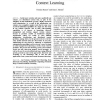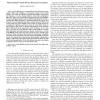611 search results - page 111 / 123 » Using GP to Model Contextual Human Behavior |
113
click to vote
NIPS
2008
15 years 1 months ago
2008
Research in animal learning and behavioral neuroscience has distinguished between two forms of action control: a habit-based form, which relies on stored action values, and a goal...
CHI
2010
ACM
15 years 6 months ago
2010
ACM
Programming has recently become more common among ordinary end users of computer systems. We believe that these end-user programmers are not just coders but also designers, in tha...
101
click to vote
ECAL
1995
Springer
15 years 3 months ago
1995
Springer
Neither `design' nor `evolutionary' approaches to building behavior-based robots feature a role for development in the genesis of behavioral organization. However, the n...
105
click to vote
CORR
2004
Springer
14 years 11 months ago
2004
Springer
Social insect societies and more specifically ant colonies, are distributed systems that, in spite of the simplicity of their individuals, present a highly structured social organi...
114
click to vote
TSMC
2010
14 years 6 months ago
2010
In a 2002 paper, we combined fuzzy logic with discrete-event systems (DESs) and established an automaton model of fuzzy DESs (FDESs). The model can effectively represent determinis...


